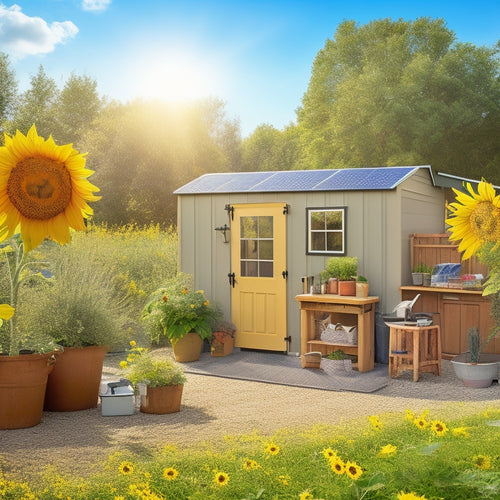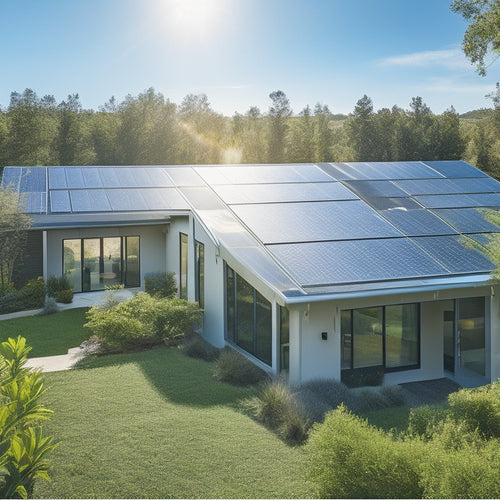A Greener Home Office: Integrating Solar Technology Into Desk Setups
Share
By integrating solar technology into your desk setup, you'll greatly reduce your reliance on traditional energy sources and create a more sustainable home office that not only benefits the environment but also your wallet. With the right solar panels, you can maximize energy output and enjoy reduced energy bills and a clear conscience. Consider desk-friendly charging options that integrate seamlessly into your workspace, and optimize your setup for maximum energy harvesting potential. As you explore the world of solar-powered home offices, you'll discover the tips and tricks to creating a truly sustainable workspace that's good for you and the planet - and there's more to uncover.
Key Takeaways
• Incorporate high-efficiency solar panels (>20% rating) to maximize energy output in your home office setup.
• Choose desk-friendly solar charging options that integrate seamlessly with your workspace, considering portability and power output trade-offs.
• Optimize solar panel placement and angle to ensure optimal sunlight absorption and energy harvesting potential.
• Select energy-efficient devices with power-saving features, such as ENERGY STAR certification, to reduce energy consumption and electronic waste.
• Consider DIY solar installation with proper tools and safety precautions to harness renewable energy and reduce your carbon footprint.
Solar Power for Home Offices
When setting up a home office, incorporating solar power can greatly reduce your reliance on traditional energy sources and lower your carbon footprint. You'll be debunking common solar myths, such as the misconception that solar panels are unattractive, as modern designs blend seamlessly into your office decor.
By harnessing renewable energy, you'll enjoy reduced energy bills and a clear conscience. As you design your eco-friendly workspace, consider the placement of solar panels to maximize energy absorption. With precise planning, you can create a sustainable and efficient home office that not only benefits the environment but also boosts your productivity.
Choosing the Right Solar Panels
What specifications should you look for in solar panels to guarantee they efficiently power your home office setup?
When choosing the right solar panels, consider the following key factors:
-
Efficiency rating: Look for panels with high efficiency ratings (above 20%) to maximize energy output.
-
Solar Panel Durability: Make sure the panels are built with durable materials and have a long lifespan (at least 25 years) to withstand outdoor conditions.
-
Panel Mounting Options: Consider the mounting options available, such as roof-mounted, wall-mounted, or adjustable mounts, to ensure a secure and flexible installation.
- Certifications and warranties: Verify that the panels meet international standards (e.g., UL, IEC) and come with extensive warranties (at least 10 years) for added peace of mind.
Desk-Friendly Solar Charging Options
You'll need a desk-friendly solar charging solution that seamlessly integrates with your workspace, and fortunately, there are several options available that can efficiently recharge your devices. When choosing a solar charging solution, consider the trade-off between portability and power output. A clutter-free workspace is essential, so look for compact and sleek designs that won't add to the solar clutter.
| Product | Portability and Power |
|---|---|
| Anker PowerPort Solar | Compact and lightweight, 15W output |
| RAVPower Solar Charger | Foldable and portable, 24W output |
| BigBlue 3 | Ultra-compact, 28W output |
| ECEEN Solar Charger | Waterproof and foldable, 13W output |
| Nekteck Solar Charger | Portable and compact, 21W output |
These options offer a range of portable power solutions, allowing you to stay connected while maintaining a clutter-free workspace.
DIY Solar Installation Essentials
By delving into the world of DIY solar installation, you're taking the first step towards harnessing renewable energy and reducing your carbon footprint.
To guarantee a successful installation, it's vital to focus on the essentials. Here are the key elements to prioritize:
-
Roof preparation and mounting options: Confirm your roof is ready for solar panels and choose the right mounting system for your setup.
-
Wiring safety and inverter placement: Follow proper wiring safety protocols and strategically position your inverter for efficient energy conversion.
-
Tool selection and cable management: Invest in the right tools and organize your cables to avoid clutter and ensure smooth operation.
- Weatherproofing methods and grounding systems: Protect your installation from the elements and establish a safe, grounded system.
Maximizing Energy Harvesting Potential
To maximize your energy harvesting potential, make sure your solar panels are angled and positioned to capture the best amount of sunlight throughout the day. This guarantees peak energy efficiency and reduces reliance on non-renewable energy sources.
Consider investing in a solar tracking system, which automatically adjusts the panel's angle to follow the sun's movement. This can increase energy output by up to 45%.
Additionally, ensure your solar panels are clean and free of debris to maintain their energy-harvesting capabilities. By optimizing your solar setup, you can increase your renewable energy output and reduce your carbon footprint.
Selecting Energy-Efficient Devices
When selecting devices for your solar-powered desk setup, you'll want to choose eco-friendly options that minimize energy consumption.
Look for devices with power-saving features, such as low-power modes or adaptive brightness, to maximize the efficiency of your solar energy harvest.
Eco-Friendly Device Options
You can greatly reduce your carbon footprint by opting for energy-efficient devices that are designed to minimize power consumption while maintaining peak performance.
When selecting eco-friendly device options, look for products with eco-labeling, such as the ENERGY STAR certification, which guarantees devices meet energy efficiency standards. Additionally, contemplate devices made from sustainable materials, reducing electronic waste and promoting a more circular economy.
Here are some eco-friendly device options to contemplate:
-
Energy-efficient monitors: Look for monitors with low power consumption and sustainable materials.
-
Eco-friendly keyboards: Opt for keyboards made from recycled materials and with low power consumption.
-
Sustainable printers: Choose printers with energy-saving features and made from recyclable materials.
- Energy-harvesting devices: Explore devices that harness energy from solar or kinetic sources, reducing reliance on non-renewable energy sources.
Power-Saving Features
By integrating power-saving features into your devices, you can greatly reduce energy consumption and minimize your environmental impact. One effective way to do this is by incorporating energy meters, which monitor and display your energy usage in real-time. This allows you to identify areas of inefficiency and make adjustments accordingly. Additionally, consider devices with automatic shutters, which can automatically turn off devices when not in use, reducing standby power consumption.
| Feature | Description | Benefit |
|---|---|---|
| Energy Meters | Monitor energy usage in real-time | Identify areas of inefficiency |
| Automatic Shutters | Turn off devices when not in use | Reduce standby power consumption |
| Power-Saving Modes | Adjust device settings for efficiency | Optimize energy usage |
Overcoming Common Solar Challenges
Solar-powered desk setups often succumb to inconsistent energy supply due to intermittent sunlight. This challenge can be tackled with strategic system design and component selection. You can overcome this hurdle by understanding common solar challenges.
Here are some energy hurdles to take into account:
-
Intermittent Sunlight: Plan for varying sunlight levels by incorporating energy storage solutions.
-
Energy Hurdles: Select high-efficiency solar panels and optimize your system's power output.
-
Solar Myths: Debunk misconceptions about solar technology, such as the idea that it's unreliable or expensive.
- System Maintenance: Regularly inspect and maintain your solar setup to ensure peak performance.
Creating a Sustainable Workspace
Designing a sustainable workspace starts with optimizing your desk setup to maximize energy efficiency and minimize environmental impact. You're not just creating a workspace, you're crafting an ecosystem.
Invest in ergonomic furniture that promotes comfort and reduces waste. Consider repurposing or upcycling old furniture to reduce landfill waste.
Next, harness natural lighting by positioning your desk near a window. This reduces the need for artificial lighting, which can account for up to 10% of your energy consumption.
Frequently Asked Questions
Can I Use Solar Power to Charge My Laptop During a Blackout?
"You can rely on solar power to charge your laptop during a blackout by investing in a backup system, ensuring uninterrupted work, and incorporating emergency planning to keep you productive and in control."
How Do I Determine the Correct Solar Panel Size for My Desk?
To determine the correct solar panel size for your desk, you'll need to conduct an energy audit to calculate your laptop's energy needs, considering factors like panel orientation, and then select a panel that meets those requirements.
Are Solar-Powered USB Hubs a Reliable Charging Option?
"Imagine a medieval knight powering their gadgets; you too can harness the sun's energy with solar-powered USB hubs, offering reliable charging options with impressive solar efficiency and moderate charging speeds, perfect for your devices."
Can I Integrate Solar Panels With Existing Office Lighting Systems?
You can integrate solar panels with existing office lighting systems by making wiring modifications to connect the panels to your lighting circuit, increasing energy efficiency and reducing your reliance on non-renewable energy sources.
Will Shading From Nearby Objects Affect Solar Panel Efficiency?
You'll want to assess how tree shadows and building orientation impact your solar panel efficiency, as even partial shading can greatly reduce energy output, so consider ideal panel placement to minimize these effects.
Related Posts
-

Building an Emergency Backup Solar Power System in 5 Essential Steps
Building an emergency backup solar power system involves five key steps. First, assess your daily energy needs to ide...
-

Top Camping Water Bottles for Adventure
When you're out adventuring, picking the right camping water bottle is essential for staying hydrated. Look for durab...
-

Installing Metal Solar Roofs for Maximum Energy Efficiency
Installing metal solar roofs can drastically enhance your home's energy efficiency and durability. These roofs withst...


